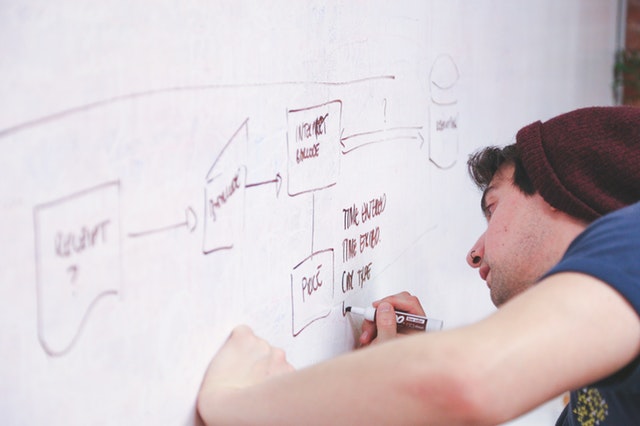
Whatever became of that mantra encouraging software companies to “Fail Fast” or “Fall Forward”? Most companies that followed a deliberate plan to release half-baked product fulfilled their destiny – they failed!
“I’ve learned the “fail often” approach is unlikely to improve an organization. I learned this because I failed often when trying it.” – Jared M. Spool, founder of User Interface Engineering
Don’t plan to fail, plan to succeed!
Failure is expensive. It costs millions in investment, reputation, confidence, and market opportunity. With any new product or solution, the cards are already stacked against user adoption. That is why we urge our clients to invest the necessary time and resources on a plan geared for success.
Don’t be tempted to charge ahead under the false belief that failing fast — and then pivoting on a dime — is a reasonable strategy. In doing so, you ignore simple, practical ways to minimize risk.
My team has spent years tackling complex software design projects. Experience has taught us that there are no viable shortcuts in product development. The reckless approach wastes a lot more money and time than following a proven recipe for success — one that will allow you to work smarter without needlessly extending your launch timeline.
I have experienced, over and over, how following 6 key steps can save you a lot of needless pain, mitigate risk, and help ensure product success:
#1: Are you solving a problem that matters?
Can everyone on your team articulate the problem your product solves in the same one or two sentences? If not, it could be that you haven’t identified your product’s true reason for being.
Successful products do more than make things easier for the customer – they solve a fundamental problem no one else addressed. Don’t design lookalike products. And don’t spend all your time and energy tackling easy problems. Create something meaningful that meets a real, possibly neglected, customer need.
Speaking of customers, I can’t stress enough (I’m shouting from the rooftops here), how essential early user validation is, especially if you are in the angel funding stage. Do your market research. Spend the time (even a little time!) to figure out if there’s actually demand for your product.
Guerrilla research methods such as quick surveys, focus groups and in situ research take only a couple of weeks and a few thousand bucks. Whatever you learn will either help prove your concept’s value or give you the chance to pivot before investing time, money, and energy building a product that nobody wants. Pivoting isn’t something you do in reaction to full-on failure. If you’ve done your due diligence, then the only reason to pivot is a change in your market.
#2: Trust the process
My staff tells me I sound like Nick Saban, University of Alabama football coach, who attributes his four national championships in the past eight years to “The Process,” a philosophy that vehemently emphasizes preparation. I’m on board with that!
Once you’ve got a solid product concept, design and refine a prototype. But don’t build yet! You have valuable things to learn during the entire product development process — throughout the stages of defining, designing, prototyping, testing and building.
You won’t save time or money if you jump straight into the build phase. You can compress stages, but you can’t skip or re-arrange them. If you do, you’ll pay a steep price later in the form of rework, missed deadlines, and wasted resources. It’s almost always more expensive and time consuming to develop a “quick and cheap” product.
“Shortcuts make long delays.” – J.R.R. Tolkien, Pippin, The Fellowship of the Ring
#3: Build the right team – in the right order
If you were building your dream house, you’d develop blueprints prior to breaking ground, right? Successful product design needs the same strategy. Most companies hire developers, then product engineers, then a UX team. That’s backwards. Don’t waste money building an unsound product concept, no matter how cheap your dev team is! Take time with proven professionals to flesh out and design a worthwhile product first. That requires people who understand user experience and product design, not programmers. Then validate your concept with a prototype, refine, then build.
By waiting to staff a development team until you actually have a worthwhile product to build you will save money and avoid the urge to “feed the beast” – that crazy instinct to have your developers do something, anything, because you can’t stand paying them to just sit around! Remember, it costs at least 20x more to fix or redesign a product feature after it’s been built than to get it right during the concepting and design phase.
#4: Say it with me: It’s ALL about the user
“When your business physically interacts with people in a way that can have a profound impact on their life, quality beats pace, every time.” – Richard Branson, founder of Virgin Group
Agile product development often forgets the customer. It’s shocking how many companies are completely divorced from their end users. What’s the solution? Iterative usability testing.
Very few startups leverage usability testing because they worry they’ll discover they’re on the wrong track, which will slow them down! Never turn a blind eye when it comes to your product. Course correct ASAP!
The single largest risk to a fledgling product or service is lack of user adoption. Usability testing minimizes that risk quickly and inexpensively. Validate your ideas with users every step of the way to guarantee you’re not straying from what they find useful and desirable. Never assume you know what’s best for your user. I’ve conducted usability tests on countless product prototypes over the years. I always learn something unexpected.
And remember to do usability testing the right way, meaning throughout the process, not at the end. Show early, cheap prototypes to realistic representative product users. Remember, you can discover 85% of your product’s usability problems by testing with just 5 users! That’s 1 – 2 days out of a sprint to correct the majority of user experience issues that might otherwise tank your product.
#5: Forget about being first.
Don’t fear the competition’s speed to market. The traditional belief that having the “first mover advantage” will make you a new market winner is totally false. Want proof? Apple Maps. Crystal Pepsi. Sony Betamax. Steve Blank of Business Insider maintains that originators tend to launch without understanding customer problems or without the necessary product features to solve the problems.
“‘Does it better’ will always beat ‘Did it first.’” – Aaron Levie, CEO of Box
Companies with innovative products or services often target Innovators or Early Adopters only. That allows other companies to enter later and grab majority market share from the Early Majority and Late Majority.
My point: once you have validated your product concept with some basic market research and user testing, stick to your vision and stay the course. Resist “shiny objects” such as replicating the new feature your competitor releases. Resist going to market before the product delivers any meaningful value. These clichés are true: 1) Better usually wins over first; and 2) You only get one opportunity to make a first impression.
#6: Finish the job
Plan for support. This lesson may seem minor, but ignoring it can sink some beautiful ships. Your product’s learning curve will vary across different levels of user sophistication. Integrate simple help guides, tooltips, and/or FAQs, within your product. Lack of available user help can cripple a small organization.
Your help documentation needn’t be exhaustive, but you should provide enough information to ensure successful product use. And use a real writer/content specialist, don’t leave this critical step to your developers! It would be a shame to let your investment falter just as you are within yards of the goal line. Before you celebrate launching your innovation, plan for success all the way through.
A time-tested process will keep you sane and centered and thwart a fear-driven sense of urgency. As you develop digital products, commit to a sequenced set of activities and deliverables, and remember — Smart can still be fast! In fact, it’s the fastest route to success I know.
If you have found these ideas and best practices helpful, or if you have thoughts about designing digital products, feel free to reach out. We’d love to hear you share your successes and failures.






